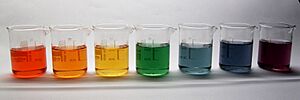Universal indicator facts for kids
A universal indicator is a special chemical tool used to find out how acidic or basic a liquid is. It helps us measure something called the pH value. Think of pH as a scale from 0 to 14 that tells us if something is an acid, a base, or neutral (like pure water).
This indicator is actually a mix of several different chemicals. Each chemical changes color at a different pH level. This means that when you add the universal indicator to a liquid, it will turn a specific color, telling you the liquid's pH.
What the Colors Mean
The universal indicator shows a range of colors, and each color tells you something important about the liquid's pH.
- Red means the liquid is a strong acid. This is for liquids with a pH less than 3.
- Orange or Yellow means the liquid is a weak acid. This is for liquids with a pH between 3 and 6.
- Green means the liquid is neutral. This is for liquids with a pH of exactly 7, like pure water.
- Blue means the liquid is a weak base. This is for liquids with a pH between 8 and 11.
- Violet or Purple means the liquid is a strong base. This is for liquids with a pH greater than 11.
Using a universal indicator is a quick and easy way to get a general idea of a liquid's pH.
Related pages
- pH indicator
- Litmus paper
Images for kids

All content from Kiddle encyclopedia articles (including the article images and facts) can be freely used under Attribution-ShareAlike license, unless stated otherwise. Cite this article:
Universal indicator Facts for Kids. Kiddle Encyclopedia.




